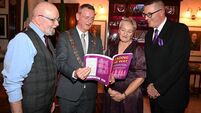How you can build healthy family dinner table routines this September

Catherine Conlon says breakfast and dinner should be eaten together with minimal, or no, ultra-processed foods at the table.
Growing up with six siblings many decades ago, as the long summer holidays eventually drew to a close and school beckoned, new regimes were needed to allow order to be restored.
Gone were the picnics, ice creams on the beach, and long days in the park; tennis and rounders interrupted by crisp sandwiches and Miwadi drinks.
Meals operated around a regime of school, after-school sports, homework, and sleep, and everyone was expected to present themselves pretty much all of the time and on time.
Sleep
Before even thinking about meals, we need to talk about sleep. The evidence shows that when sleep becomes short, everyone, including children, will gain weight as multiple forces combine to expand your waistline. The first concerns two hobbit- sounding hormones: leptin and ghrelin.
Leptin signals a sense of feeling full. When circulating levels of leptin are high, your appetite is blunted, and you don’t feel like eating.
Hunger is triggered by ghrelin. When ghrelin increases, so does your desire to eat. An imbalance in either of these hormones can trigger increased eating and increased body weight. If both hormones are out of sync, the effect is magnified further.
Researchers have examined the impact of lack of sleep on appetite. In a series of studies over three decades, participants who slept for up to eight and a half hours for five nights were compared with participants who slept for four to five hours a night for five nights.
Short sleepers were ravenous compared to those who slept for more than eight hours, despite being given the same amount of food and being similarly active. The strong rise in hunger pains and increased reported appetite happened by just the second day of short sleeping.
If that wasn’t enough, sleep deprivation also results in heightened craving for all the wrong foods - biscuits, chocolates, and crisps - compared to people who have had a full night’s sleep.
Intuitively, we know all this. If sleep has been cut short, we are far more inclined to dive into sugary snacks and junk food as our impulses are lowered and we crave anything that will boost our depleted energy reserves.
If you are keen to keep kids on a mostly healthy diet as they return to school – make sure phones and all other internet devices are removed from bedrooms every night. Kids will grumble, but they will secretly thank you for it as their brains switch off and a full night’s sleep follows.
Ample sleep can restore impulse control within the brain and put the appropriate brakes on excessive eating.
Meals and snacks
In my day, school mornings started with Weetabix, brown bread, toast, and a glass of milk, while cornflakes were reserved for weekend. Twenty minutes around the table – discussions around what lay ahead and who needed to find football boots, sports bags, bus money, or signatures on school notes. Preparation was key and everyone had a job.
Most primary school kids are offered hot school meals for lunches. Secondary school lunches can be trickier. Leftovers from last night’s dinner can be handy, nutritious and filling. The key is to make sure each meal/snack has a piece of fruit or vegetable – berries, lettuce, celery, cucumber, tomatoes, apples, bananas, kiwis… the list is endless once it becomes a routine.
Dinner in our house was always at 5pm and compulsory. It doesn’t have to be complicated. Pasta with mushrooms, onions, garlic, tinned tomatoes, and pesto cooked with egg yolks or a little cream is delicious for almost everyone. Stir-fries with chicken are equally nutritious and can be pulled together in 20 minutes, adding a mixture of vegetables – onions, garlic, mushrooms, courgettes, tomatoes, celery, spinach.
Everyone can get involved in chopping, stirring, and serving. It’s an opportunity to pass on the life-long gift of the joy of good food while creating healthy habits and allowing kids to de-stress about their day.
Banned from the dinner table are phones, electronic devices, and ultra-processed food.
Snacks are important for growing kids but should be centred around fruit, cheese, wholemeal crackers, unflavoured yogurts, and wholemeal breads. I grew up with the smell of brown bread and scones and apple pie in the kitchen. I still remember arriving in from school and the smell of fresh fruit scones hitting my senses.
Why are we losing these skills? Nothing tastes as good as home cooking, and they are so much cheaper and tastier than filling the cupboards with processed foods, covered in plastic that are designed for over-consumption. How long does it take to make a Victorian sponge – eight ounces of flour, sugar and butter mixed with four eggs, a teaspoon of baking powder, and whisked into the oven for 30 minutes? Filled with jam and dusted with icing sugar, does anything taste better? Home-cooked food doesn’t have to be complicated and is deliciously free of additives that play host to cravings for more.
The best drinks are water and milk - no free sugars.
Physical activity
As important as sleep for a healthy diet during the school year, is physical activity. We know that when kids are lounging on couches or in bedrooms, they are snacking mostly on unhealthy foods laden with fat, sugar, and salt.
Irish research tells us that just one in five primary school children and one in ten secondary school students meet the WHO recommendations of 60 minutes of physical activity daily.
At the same time, from a pre-pandemic study of over 6,000 primary and secondary school children, only a third commute to school by walking and cycling, and parents are a big part of the problem with an ongoing heavy reliance on car commutes.
Six out of ten primary school students (57%) travel to school by car, while a third walk, less than one in ten (7%) use public transport, and a tiny fraction (3%) cycle.
One in three (33%) secondary students use private transport for the school commute, with just over a third (37%) using public transport, a quarter (28%) walking and hardly any (2%) cycling to school.
Barriers to active travel identified by students include heavy school bags, heavy traffic, and unsafe road crossings. But cycling and walking offer more than just physical activity – they offer independence, critical to mental wellbeing as young people mature into young adults.
A healthy diet must be considered in the context of patterns of sleep and movement. Patterns of behaviour from an early age that embed healthy habits around sleep, diet and movement are key preventative measures for the health and wellbeing of children and teenagers.
Priorities
If I had children returning to school this autumn – I would focus on three areas. A minimum of eight hours of sleep every night. Fruit or vegetables with (almost) every meal or snack; and breakfast and dinner eaten together with a minimum of ultra-processed foods and phone-free. At least an hour of physical activity every day – most easily incorporated by ensuring a walk or a bike ride or a bus to and from school.
It sounds challenging, but we managed all of this decades ago before life got so complicated and busy. We have to rethink our priorities and ensure every child gets the sleep, diet and movement they need to flourish in a complicated and often chaotic world.
- Dr Catherine Conlon is a public health doctor in Cork.







 App?
App?


